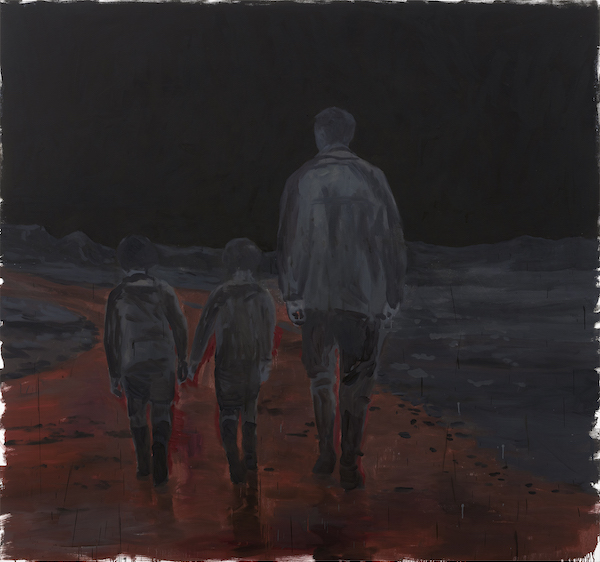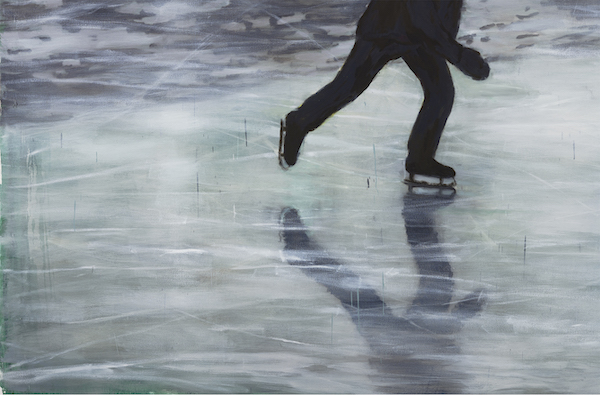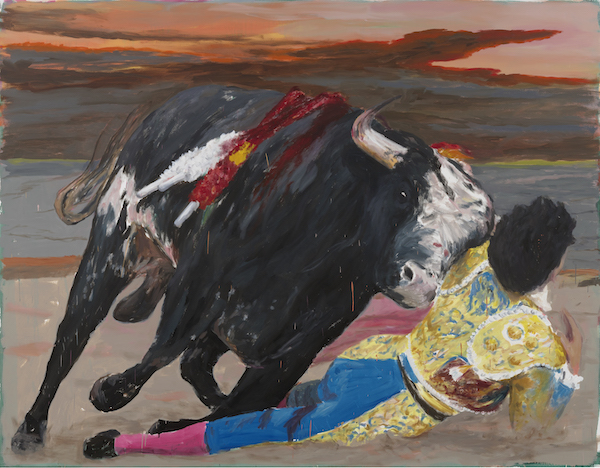Enrique Martínez Celaya is embarking on a new journey, and we are faithfully following in his wake. The masterful Cuban-American painter had his first solo exhibition in LA since 2015, “The Tears of Things,” at Kohn Gallery this September. The artist took full advantage of the gallery’s sweeping ceilings, working in his preferred large scale to create a body of work that reveals the nature of his concerns.
One month before his exhibition, I was invited to interview Martínez Celaya at his sprawling Culver City studio. His studio director greeted me and ushered me into the artist’s workspace where I was hit by a wall of sound. To the blaring music of Aerosmith, Martínez Celaya was working on the centerpiece for his show, The Reign, a large oil-and-wax painting featuring an apple tree in a winter landscape. Feeling my gaze upon him, he gestured for me to please wait a minute while he finished up. After a few more rapid brushstrokes, he left the room, and Steven Tyler was silenced mid-howl.

Enrique Martínez Celaya, The Lesson, 2019
Martínez Celaya, not a stranger, swiftly greeted me, and then was off, motioning for me to follow him. I jogged, trying to keep up with the artist, who was clearly still riding a wave of creative adrenaline.
He gave me an expedited tour of his mock-up of the Kohn Gallery installation and a quick run-through of works in progress. We sat before one work that seemed nearly finished, The Virtue, a painting of a solitary skater gliding across a huge body of frozen water with snow-covered hills in the background. The skater is tightly bundled up, as one must be to survive in such a frigid atmosphere. Across the top of the painting was inscribed a quote by Robert Frost: “Here are your waters and your watering place.”
Martínez Celaya used to write his own words on his paintings, but as of late he prefers to include phrases by writers he respects; this is done partly to deter viewers from assigning an autobiographical narrative to his work.
We talked about the multitude of allusions in The Virtue, and how metaphor is critical to his work. The ice sheet represents the idea of something essential, like water: “In the wrong place, it’s inaccessible,” and the relevance of the well-known phrase “skating on thin ice.”

Installation view of The Reign, 2019
Martínez Celaya also revels in the power of his primary medium, paint, and the ways in which it can trick the mind. He paints abruptly, roughly, to keep viewers suspended within an idea we can almost hold but is just out of reach. For example, the inhospitable environment of The Virtue is visually driven home with a puff of the skater’s breath that freezes immediately upon hitting the air, partially obscuring his or her face.“The entire painting was made pretty much just to have the breath,” said Martínez Celaya.
His prowess with metaphor and paint is undeniable as he produces work after work of representational imagery—usually a young boy or girl, or an animal, or both, in a landscape—layered with meaning, yet denying a narrative. “In my work, there’s always a balance with the reference, never getting too much into storytelling… but always a fragment of a narrative,” he said. Through metaphor, the artist intentionally gives the viewer the power to project personal experiences onto his images, encouraging an intimate connection to his work.
While each painting suggests mere fragments of stories, the totality of work in “The Tears of Things” does indeed tell a narrative—and a personal one at that, despite Martínez Celaya’s best efforts at concealment. Front and center across the board are images that reflect his ruminations on the elements of hope and risk in new journeys through such diverse imagery as a well-trodden golden landscape, a matador taking on a bull, a skater gliding across thin ice, a man with children walking through a “dome of darkness.” These paintings seemingly embody the paradigm shifts he has frequently ignited in his own life.

Enrique Martínez Celaya, The Virtue (detail), 2019
Most people don’t know, for example, that Martínez Celaya was once a successful physicist and inventor of lasers. Leaving science for art in his early 20s “was my first rebellion,” he said, adding, “I wanted to be in the world as an artist.” More recently, the artist took a huge risk by leaving LA Louver, one of the most important and historically respected blue-chip galleries in town. He also went through a divorce, a “rebellion against my own idea of the good.” These were not small adjustments but massive alterations undertaken with the belief that happiness—currency equal to gold—would be waiting at the end of his journey.
The key to his success, perhaps, is that Martínez Celaya takes these risky, dramatic and self-assured changes of course with a certain sense of grace. “I wanted this [show] to not be so obvious: ‘A bullfighter and a skater, what is the relationship?’ Well, they’re both in this endeavor in which they launch themselves in some glamor outfit of some sort, and there’s a risk—risk of death or drowning. A lot of it depends on grace, as you glide, as you wear this fancy outfit. The relationship between grace and risk; the two of them seem to be the same.”


